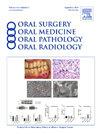Vertebral artery calcifications: a comprehensive review
IF 2
3区 医学
Q2 DENTISTRY, ORAL SURGERY & MEDICINE
Oral Surgery Oral Medicine Oral Pathology Oral Radiology
Pub Date : 2025-02-04
DOI:10.1016/j.oooo.2024.11.070
引用次数: 0
Abstract
Clinical Presentation
Vertebral artery calcifications are a significant finding in medical imaging and often are associated with cerebrovascular diseases. Vertebral artery calcifications are characterized by the accumulation of calcium within the walls of the vertebral arteries. There are several risk factors that have been associated with the development of vertebral artery calcifications, including age, hypertension, diabetes mellitus, dyslipidemia, smoking, and chronic kidney disease. The prevalence of vertebral artery calcifications is known to affect 21% of the general population and is common in the elderly. The presence of vertebral artery calcifications has also been linked to an increased risk of transient ischemic attacks and strokes which could cause death.
Differential Diagnosis
Radiographically, vertebral artery calcifications appear either unilaterally or bilaterally at the level of the foramen magnum, appearing as circular or semi-circular masses. These characteristic features are pathognomonic of vertebral artery calcifications.
Diagnosis and Management
Noninvasive techniques, such as computed tomography and magnetic resonance imaging, are commonly used to visualize and quantify the extent of vertebral artery calcifications. Additionally, ultrasonography can be used to assess the flow characteristics of vertebral arteries in relation to vertebral artery calcifications. The treatment of vertebral artery calcifications involves addressing underlying risk factors to prevent further progression of arterial calcification. Lifestyle modifications, including smoking cessation, blood pressure control, lipid management, and glycemic control, play a crucial role in reducing the burden. In severe cases, surgical interventions such as endovascular procedures or surgical bypass may be considered to restore normal blood flow.
Conclusion
Vertebral artery calcifications represent an important clinical entity associated with cerebrovascular diseases. Recognizing the risk factors, understanding the pathophysiology, and using appropriate diagnostic tools are essential for early detection and effective management. Further research is warranted to explore the optimal therapeutic strategies and long-term outcomes related to vertebral artery calcifications.
求助全文
约1分钟内获得全文
求助全文
来源期刊

Oral Surgery Oral Medicine Oral Pathology Oral Radiology
DENTISTRY, ORAL SURGERY & MEDICINE-
CiteScore
3.80
自引率
6.90%
发文量
1217
审稿时长
2-4 weeks
期刊介绍:
Oral Surgery, Oral Medicine, Oral Pathology and Oral Radiology is required reading for anyone in the fields of oral surgery, oral medicine, oral pathology, oral radiology or advanced general practice dentistry. It is the only major dental journal that provides a practical and complete overview of the medical and surgical techniques of dental practice in four areas. Topics covered include such current issues as dental implants, treatment of HIV-infected patients, and evaluation and treatment of TMJ disorders. The official publication for nine societies, the Journal is recommended for initial purchase in the Brandon Hill study, Selected List of Books and Journals for the Small Medical Library.
 求助内容:
求助内容: 应助结果提醒方式:
应助结果提醒方式:


